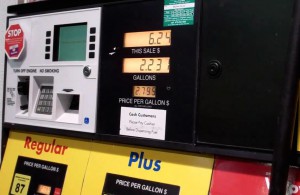
Gas prices are below $2 a gallon across the country due to low crude prices with only the West Coast still above $2.
Even as intense winter storms system swept through the Southeast and Mid-Atlantic states, the price of gasoline continued to drop across the United States, according to new survey from AAA.
Average gas prices have spent 25 consecutive days below $2 per gallon and could head lower still as reduced seasonal demand and falling crude oil costs combine to send pump prices to the lowest mark in six years.
Today’s average price of $1.83 per gallon is the cheapest price since January 2009, and retail averages have fallen for 69 of the past 80 days for a total savings of 40 cents per gallon over this span, AAA reported.
Crude oil supply continues to outpace demand, which has helped push gas prices down by seven cents during the previous week, 18 cents on the month and 21 cents on the year, AAA said.
(Automakers working on making “good” vibrations. For more, Click Here.)
An historic blizzard hit the Northeast over the weekend and the Mid-Atlantic was the hardest region hit, and a number of states in the area received more than two feet of snow, AAA noted. Severe weather can make it difficult for refiners to produce gasoline and can create hurdles for getting the product to market. However, storms also keep drivers off of roads, which can limit demand.
Early reports indicate that PBF Energy shut down its Delaware City refinery, citing power failure due to the blizzard conditions. Averages in the region could possibly move higher in the coming days if refinery and distribution problems persist, AAA said.
Motorists in just 11 states and Washington, D.C. are paying an average above $2 per gallon. California at $2.67 continues to lead the market, however, the resolution of refinery issues in the state has narrowed the difference between the Golden State and second-place Hawaii at $2.63.
Regional neighbors Alaska at $2.44, Nevada at $2.34 and Washington at $2.24 round out the top five most expensive markets for retail gasoline. Consumers in Oklahoma at $1.53 and Missouri at $1.54 are paying the nation’s lowest averages at the pump, followed by the Midwestern states of Indiana at $1.55, Ohio at $1.56 and Michigan at $1.59.
(Click Here for details about the growth of Green vehicles and the awards that go with them.)
Global oversupply and the anticipation that additional oil will soon enter the market with the lifting of sanctions on Iran, contributed to both benchmarks — Brent and West Texas Intermediate — trading last week at lows unseen since 2003. Market fundamentals remain unchanged and a “lower-for-longer” sentiment is beginning to prevail amongst speculators.
Talks are now shifting to whether the market has reached its bottom and if, or when, the necessary adjustments in supply will occur in order to help bring the crude oil market more into balance, AAA reported.
However, analysts from the Lundberg Letter, have noted that gasoline retailers have increased their margins on gasoline in the wake of the big drop in the price of crude oil, which shows no sign of abating since Iran was allowed to re-join the global economy and global oil market as the Iranian government new deal on nuclear weapons with the U.S. and European nations is being implemented.
Although oil prices did move higher for a time, the lower-for-longer prices are also beginning to lead to speculation about what has been described as “collateral damage,” such as impact on other assets and the energy sector in general. Lower oil prices have contributed to the instability in global stock and bond markets.
(To see more about how a fuel cell vehicle works, Click Here.)
Nonetheless, analysts expect the oil market to begin to rebalance in 2016, but a number of questions remain such as the full impact of Iranian oil returning to market and whether a slowdown in economic growth across the globe will make it more difficult ease the glut in supply. In addition, the wider use of renewable energy in various forms also appears to be having an effect on the ability of oil producers to raise prices.
